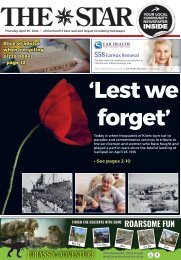Style: August 03, 2017
You also want an ePaper? Increase the reach of your titles
YUMPU automatically turns print PDFs into web optimized ePapers that Google loves.
18 STYLE | interview<br />
It was a novel about Vincent van Gogh, plucked from a library shelf<br />
during a cold Canterbury winter that first piqued a 14-year-old<br />
Denis Savill’s interest in the world of art. Brought up on a high country<br />
sheep station outside of Hanmer Springs, Savill spent much of his<br />
childhood in Christchurch, boarding first at Medbury, then at Christ’s<br />
College during his formative years.<br />
A desire to see the world saw 20-something Denis travel<br />
throughout Europe before settling in London, where he was reintroduced<br />
to art when a friend encouraged him to get involved<br />
with a nearby auction room, which happened to sell many works of<br />
Australian and New Zealand origin.<br />
Not quite finished with travelling, however, the young Kiwi soon<br />
moved to Zimbabwe (then Rhodesia), where he talked his way into a<br />
job with an auction house. The work was diverse and varied, with lots<br />
that ranged from livestock and real estate to, yes, art. Savill was one of<br />
the few who recognised the investment potential of the works he saw,<br />
commenting, “I was fascinated by these paintings, bearing in mind what<br />
I’d been told in London.”<br />
By the 1970s, Savill had relocated to Sydney and was making waves<br />
in the art scene, quickly establishing himself as both a knowledgeable<br />
art dealer and a shrewd investor. Well ahead of his time, he<br />
recognised the value of Australasian art, and began building up a<br />
collection of works by a diverse range of artists.<br />
Purchasing Gordon Marsh Gallery in 1981, after a couple of years<br />
spent working as a private art dealer, Savill swiftly began carving out<br />
a name for himself within the industry. He caught national and global<br />
attention when, the following year, he set a record for the most<br />
expensive painting ever sold in Australia, a work by J.A. Turner that<br />
fetched $350,000.<br />
Savill confirmed his presence in the Australasian art scene by renaming<br />
and re-branding the gallery to the name it has now operated<br />
under for the last 30 years, the eponymous Savill Galleries, based in<br />
Sydney’s sought-after inner-city suburb of Paddington. Throughout<br />
the 1980s and ’90s he worked tirelessly to build up his collection,<br />
acquiring works by such respected Australian painters as Charles<br />
Blackman, Lloyd Rees and Arthur Boyd, among many others. As well<br />
as advancing his career, Savill also formed deep connections with the<br />
artists he encountered, building friendships that would go on to last a<br />
lifetime.<br />
Savill’s work has continued to command respect throughout his<br />
career, with his collection only strengthening as time has gone on.<br />
A benefactor as well, Savill has recently donated more than 200<br />
artworks to galleries throughout Australia, re-affirming his commitment<br />
to public art.<br />
In recent years, the now 76-year-old Savill has been contemplating<br />
the future of his business, and has reached the difficult decision to slowly<br />
wind down both his gallery and his presence in the salesroom.<br />
Reflecting on his long career, Savill calls to mind his dear friend, the<br />
artist Arthur Boyd, a man he regarded as a “true gent”. Recalling a<br />
conversation between them, Savill muses, “Arthur told me, ‘You’re a<br />
great acquirer, but there will come a time when you’ll feel free to give<br />
it away, you’ll feel like you’re unloading.’” Savill admits that he couldn’t<br />
understand the sentiment at the time, but as the years have passed<br />
since that conversation, Boyd’s words have come to resonate with<br />
him more and more, and have guided him in his decision to take more<br />
of a back seat in the art world. When asked how he feels about letting<br />
go of the art that has defined his life’s work, he replies with a laugh,<br />
“How come that’s the best question, and the hardest one to answer?”<br />
Of the works he’s handled over the years, he says, “They’re dear to<br />
my heart, but you can’t take them upstairs with you.”<br />
Savill partnered with respected auction house Sotheby’s last year to<br />
sell a selection of his accumulated works, including those by Charles<br />
Blackman and Sidney Nolan. The auction garnered a huge amount of<br />
interest not only from those looking to acquire the available pieces,<br />
but also from those wishing to acknowledge the reputation and legacy<br />
Savill has built over the decades. The chairman of Sotheby’s Australia,<br />
Geoffrey Smith, used the opportunity to pay tribute to Savill’s<br />
enduring contribution to the Australian art community, commenting<br />
that the auction house was “honoured to be entrusted with the sale”,<br />
and adding, “He’ll be missed more than we realise.”<br />
“They’re dear to my<br />
heart, but you can’t<br />
take them upstairs<br />
with you.”<br />
Denis Savill, Arthur Boyd Show, Savill Galleries Melbourne, 2000. Sidney Nolan The Questioning (1966).


















